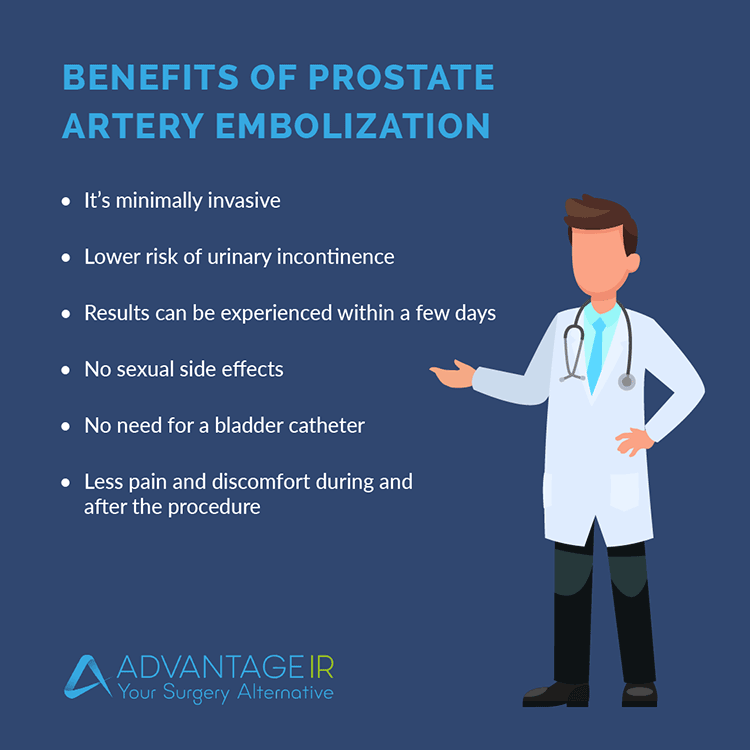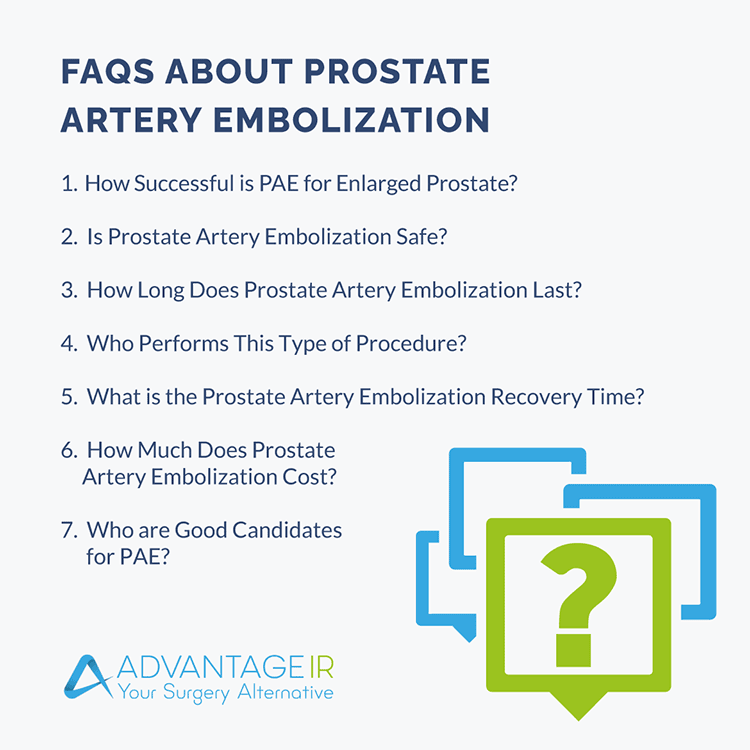How Does Prostate Artery Embolization (PAE) Work? What Patients Need to Know
We take a closer look at this alternative to TURP for patients dealing with enlarged prostate.

When most men are diagnosed with an enlarged prostate, they are typically given just one treatment option: TURP or transurethral resection of the prostate.
What they are not told is that they do not necessarily need to undergo prostate surgery. In fact, they can find relief from their symptoms with a safe, minimally-invasive procedure called prostate artery embolization (PAE).
How does prostate artery embolization work? Read on to learn more about this groundbreaking procedure.
How Does Prostate Artery Embolization Work?
PAE is a treatment that helps improve the symptoms of benign prostatic hyperplasia (BPH), a noncancerous enlargement of the prostate gland. BPH usually affects men as they age, starting in the 40s and progressing with each decade. It is estimated that 90% of men over the age of 80 years have this condition.
Instead of surgically cutting into the prostate gland, interventional radiologists can use vascular catheters to deliver tiny particles into the prostate gland’s blood vessels. The particles inhibit blood flow to the areas of the prostate most impacted by the enlargement, reducing the size of the prostate by causing the prostate to shrink.
The procedure can take up to three hours depending on the needs of the patient, such as the size and location of the arteries to be embolized.
Prostate Artery Embolization Technique
The doctor may start by inserting a catheter into an artery in the patient’s groin, feeding the catheter into the blood vessels that carry blood to the prostate gland.
With the catheter in place, the doctor will inject a dye into the blood vessels (called an arteriogram) to provide a map of the blood vessels that lead to the prostate.
Tiny microspheres are injected into the catheter to reach the necessary blood vessels, thereby reducing the supply of blood to the gland. Once one side of the gland has been treated, the doctor will treat the other side.
Benefits of Prostate Artery Embolization

The benefits of the PAE procedure include:
- It is a non-invasive, outpatient procedure
- Patients can expect to see results within a few days
- Recovery time is significantly lower
- Less risk of urinary incontinence
- Less risk of sexual side effects
- No retrograde ejaculation
- Less pain/discomfort during and after the procedure
Patients who have BPH typically suffer from the following symptoms:
- Difficulty starting the urination process
- Frequent and urgent need to urinate
- Weak stream of urine or a stream of urine that stops and starts
- Increased nocturnal urination (which significantly and adversely impacts sleep)
- Inability to empty the bladder fully
- Post-urination dribbling
- Complete inability to urinate
- UTIs (urinary tract infections)
- Blood in the urine
Once a man undergoes this procedure, it typically takes a couple of weeks to get relief and feel like his body is functioning like it did when he was younger.
How Does PAE Differ from Other BPH Treatment Options?
PAE is not the only procedure available to men dealing with an enlarged prostate. Here is a look at two other procedures commonly recommended to those suffering from BPH.
Prostate Artery Embolization vs. UroLift
An alternative to prostate artery embolization is the UroLift procedure. During this treatment, a doctor uses small implants to hold the prostate tissue away from the urethra.
The UroLift System has its limitations, though. It is not a one-size-fits-all remedy to enlarged prostate. The procedure is only suitable for men with smaller prostate glands and not effective for those who have a large median lobe (a part of the prostate that can grow into the bladder, something that affects at least 10% and up to 40% of men).
Prostate Artery Embolization vs. TURP
Transurethral resection of the prostate (TURP) is a common type of prostate surgery. A doctor inserts a resectoscope (a tool that consists of a wide-angle microscope for exploration and a wire loop that can cauterize and remove tissue) into the tip of the penis and through the urethra. Using that tool, the doctor trims away excess prostate tissue, thereby restoring proper urine flow.
Though TURP is considered a minimally invasive procedure, it is still a form of surgery, which brings with it some downsides, including:
- Temporary difficulty with urination
- Dry orgasms
- Erectile dysfunction (ED)
- UTIs
- Heavy post-operative bleeding
- Low blood sodium levels
- Urinary incontinence
Based on these side effects alone, PAE is a safe and attractive alternative to TURP.
FAQs: Top 7 Questions about PAE

Once patients suffering from benign prostatic hyperplasia learn about prostate artery embolization, they tend to have a lot of follow-up questions. Here are some of the most common questions asked about this procedure.
1. How Successful is PAE for Enlarged Prostate?
In a 2020 study, researchers found that PAE was as effective as TURP at relieving urinary symptoms. Researchers also pointed out two areas in which PAE was a better alternative to TURP:
- PAE patients had a greater improvement in quality of life scores compared with TURP patients.
- There were fewer adverse events reported in the PAE group than in the TURP group.
2. Is Prostate Artery Embolization Safe?
In the study mentioned above, one-third of PAE patients experienced mild side effects or urinary retention. No major complications occurred in the PAE group. Conversely, the TURP group experienced three times as many complications as the PAE patients.
3. How Long Does Prostate Artery Embolization Last?
One of the main concerns men have about various BPH treatment options is how long they will last. Their concern is valid for multiple reasons:
- They want to save money
- They do not want to undergo any more treatments than they absolutely must
- If it is possible, they do not want to deal with the symptoms of BPH ever again
Since PAE is a newer form of treatment, there are not any long-term studies. However, a study published in 2019 by João Martins Pisco of St. Louis Hospital in Lisbon, Portugal found that patients were still experiencing good results 12 months after the procedures. Based on their findings, some estimate that the effects of the PAE procedure can last at least five years.
4. Who Performs This Type of Procedure?
The doctors who perform PAE are called interventional radiologists. They are medical doctors with up to seven years of additional training post-medical school.
Interventional radiologists use specialized radiology or imaging to perform minimally invasive procedures, like prostate artery embolization. They commonly use:
- Fluoroscopy (a technique that utilizes x-rays to create a real-time “movie” of the insides of a particular body part
- MRI
- CT scans
- Ultrasound technology
- Arteriogram (the x-ray used to examine the arteries in the PAE procedure)
5. What is the Prostate Artery Embolization Recovery Time?
Mild discomfort after the procedure is common and can last for a few days post-op. Some patients feel like they are back to normal within three days of having the procedure and return to work. Others can take up to two weeks to overcome feelings of urinary discomfort.
6. How Much Does Prostate Artery Embolization Cost?
In 2017, researchers evaluated the average cost of PAE and compared it to the costs of TURP. The researchers found that, at first glance, PAE is more costly than the TURP procedure. The cost for prostate artery embolization at that time was between $1,472 and $1,680, whereas the TURP cost $1,080. However, since TURP is a procedure that must be done in the hospital, it is necessary to add in-hospital costs to get an accurate estimate. Once all the figures were gathered, the TURP procedure was nearly $5,500.
Regarding medical insurance coverage, that is entirely dependent on the patient’s insurance company and plan (including their unique deductible and co-insurance percentages). Generally, if an insurance company covers prostate surgery, they are often willing to cover prostate artery embolization.
7. Who are Good Candidates for PAE?
The best candidates for PAE are men who:
- Suffer from the most common symptoms related to enlarged prostate
- Have tried drug therapy but did not benefit from it
- Have a prostate size over 40 grams
- Cannot have general anesthesia
A patient’s doctor will also determine if they are a good candidate based on the results of various diagnostic tests, including:
- PSA levels
- Prostate ultrasound
- A urodynamic pressure study
- A cystoscopy (to examine the lining of the urethra and bladder)
- Uroflowmetry (to evaluate urine flow)
Patients that are not good candidates include those with:
- A malignant tumor
- Atherosclerosis
- A twisted pelvic floor
- Unusual prostatic vessel anatomy
The Latest News on Prostate Artery Embolization
Due to recent research showing both the effectiveness of and the minimal side effects of the PAE procedure, more people are on board with choosing this minimally invasive procedure.
Researchers, doctors, reporters, and patients are all excited about the potential for a safe, long-term treatment option that requires zero hospital days and fast results.
Here is a brief look at some of the latest news on prostate artery embolization.
- Beth Israel Deaconess Medical Center: Patient and doctor both agree that the procedure was not only effective, but that it is a complete game-changer in the medical field.
- UCSF Medical Center: Doctors say the “gold standard” for prostate care has been TURP, but they are encouraged by the research available about PAE and are excited to offer this procedure to their patients.
- NBC-2 News Report: Patient says the PAE treatment is a miracle, and that within five days, he was cured of his BPH symptoms.
See What Other Patients Have to Say about PAE
Does prostate artery embolization work? Doctors can tell their patients all about the benefits of the procedure, but there are many who want to hear from patients who have already undergone the treatment.
There is an abundance of patient testimonials on the Ask4PAE website (an educational patient program that sets out to inform men about the benefits of prostate artery embolization). Men who have had the treatment say that they no longer struggle with BPH symptoms and that they have been able to reclaim their quality of life.
Any man who has been diagnosed with enlarged prostate should talk to a healthcare professional about this minimally-invasive alternative to surgery.
Are you interested in learning more about PAE and whether you are a good candidate? The team at Advantage IR is here to answer your questions. Contact us today to schedule a consultation!
